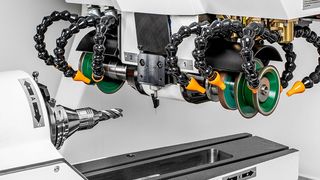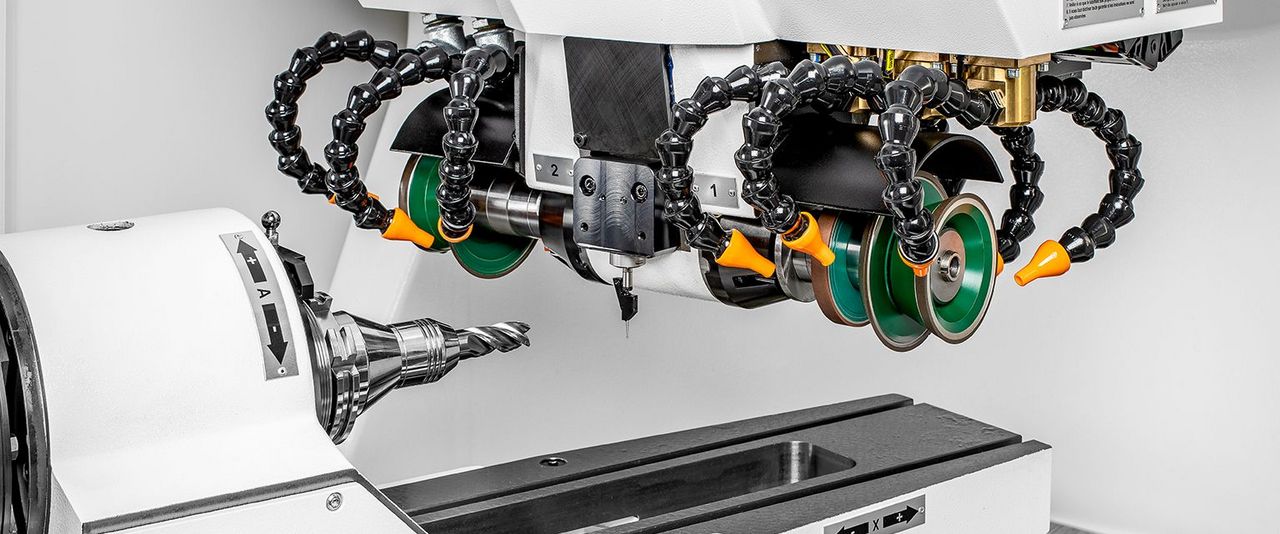Adding Functionality to CNC Grinding Machines to Streamline Production
The digital transformation of machining has meant far more than automating processes and collecting and analyzing data. It has empowered OEMs to develop more functionality in CNC grinding machines for multi-tasking, combining processes and reducing part handling while making the machines easier to operate.
These multi-function CNC grinding machines can help increase the value per operation and boost the bottom line, even with the use of carbides and other hard materials. The benefits of using these machines include:
- Lower price per part.
- Faster cycle times.
- Lower overall tooling costs.
- Higher quality.
A sampling of the functionality in the newest CNC grinding machines:
- Universal cylindrical grinders have multiple spindles, which allow for several gradations of grinding in one clamping.
- Surface and profile grinding machines can mill, drill, grind, and deburr in the same setup.
- Eroding machines can alternately erode and grind in one operation, known as the two-in-one principle, which reduces cycle times while producing fine finishes with carbide or PCD tools.
Added Functionality Means More Flexibility
Additional functionality also is built into CNC grinding machines with expanded options for workpiece support, which keep parts stable and the process running true while allowing a manufacturer to be more aggressive with the grind, which will improve cycle times. An automated Steady Rest or Tail Stock allows for auto-loading of parts and unattended production.
The emphasis on flexibility can be seen with ID/OD grinders, which have been designed for grinding from flexible positions and allow different operations in the same setup. These CNC grinding machines also hold up to four wheels and have up to three OD spindles and an ID spindle. This versatility means shoulder, taper, face, plunge and surface grinds can be completed in the same clamping.
Advances in software, grinding wheel technology, dressing processes, and measurements allow ID/OD grinders to do in one operation what it previously took up to five machines. ID/OD grinder automation can be realized with chucking, barcoding, washing, demag, deburr, measuring, laser making and more.
Keeping Wheels Sharp During Operations Is Key to Lowering Cycle Times
Some of the most significant innovations in CNC grinding machines revolve around internal wheel dressing, which not only streamlines production but also extends the life of wheels.
Continuous dressing keeps temperatures in check and wheels sharp, so lengthy cuts are possible, which drives shorter cycle times and efficiency. Continuous dress creep feed (CDCF) grinding also means reduced machine wear and longer wheel life; the cost of tooling is a fraction compared with a CNC milling machine. CDCF also may allow combinations of milling, drilling, grinding, and deburring in the same setup, which can be 40 percent faster than alternative processes. It also can eliminate the need for heat treatment and finishing.
Other advances in dressing that streamline production include:
- More positions for internal dressing, such as overhead or table dressing units, which enable continued operation.
- Electro-discharge dressing technology that uses an erosion method to remove bond material from grit without touching expensive diamond wheels.
- The addition of a coolant nozzle changer, which adds flexibility and helps minimize handling.
Some machines are able to re-true a wheel, which is especially valuable for CBN and diamond wheels. It provides value by maintaining wheel shape, which improves part consistency and extends the life of the wheel.
Measuring and Re-Grinding in the Same Operation Also Improves Quality
Combination machining and measuring also has significantly streamlined production and improved quality control. Parts can be produced repeatedly with the desired accuracies and surface finishes while reducing time for measuring.
Other increased functionality in measuring options include:
- Advanced probe capabilities mean a shop can run an operation, have the probe check the part and, if needed, tweak the program on the fly.
- Machine add-ons support in-process gauging and automatic calibration.
Software, HMIs Make it Easier to Operate CNC Grinding Machines
Software and human machine interfaces (HMIs) also have added functionality to CNC grinding machines in terms of programming, diagnostics, troubleshooting, and changeovers.
HMIs make it easier and more efficient for manufacturers to train their newest employees how to program and monitor their most sophisticated machines. HMIs simplify operations and monitoring and integrate with ERPs and other software. The benefits include:
- Operators can quickly recall previous setups and operations.
- They also can create tools from an extensive library and perform troubleshooting via dry runs or simulations on a machine without actually grinding a part.
- Operators can program future runs while a machine is in operation.
Software plug-ins expand functionality. Options include:
- Feed rate optimizer, which calculates the material removal rate (MRR) and can reduce cycle time on average by about 15 percent.
- Tool Balancer, which is important for shops running high-spindle RPMs in order to maintain shape to ensure quality finishing and the life of spindle.
- Sketcher, which allows companies without the resources for an engineering department to create a blueprint from the Tool Studio software. Not everyone has the staffing or skills to use CAD software.
Machine Tending Automation Leads to Many Production Efficiencies
Adding machine tending to a CNC grinding machine remains the most basic but effective tactic for streamlining production as it will perform repetitive and sometimes dangerous tasks. It creates a series of benefits from covering meal breaks to extending production runs beyond eight hours to lights-out production.
Some systems can link together multiple machines and workstations to incorporate gauging, statistical process control, and washing stations. Automation allows other application efficiencies to be realized with barcoding, demag, deburr, measuring, laser marking, re-grip, and more. Among the benefits:
- Repeatable precision, which boosts productivity and quality.
- Production planning becomes based on unique batch needs as opposed to people available to load a machine.
An ID/OD grinding machine equipped with machine tending automation performs over 90 percent of the necessary labor per shift. Machine tending systems also extend the skills of the existing labor force and mitigating risk as experienced skilled workers age out.
How Can You Leverage CNC Grinding Machines to Streamline Production?
The added functionality of today’s CNC grinding machines will help you meet cycle time and tolerance specs, budgetary needs, and improved repeatability. UNITED GRINDING offers best-in-class CNC grinder solutions. We work with our customers to solve challenges and help them get the most out of their machines.
Contact us today to discuss how we can collaborate to solve your challenges and get the most out of your grinding technology.









